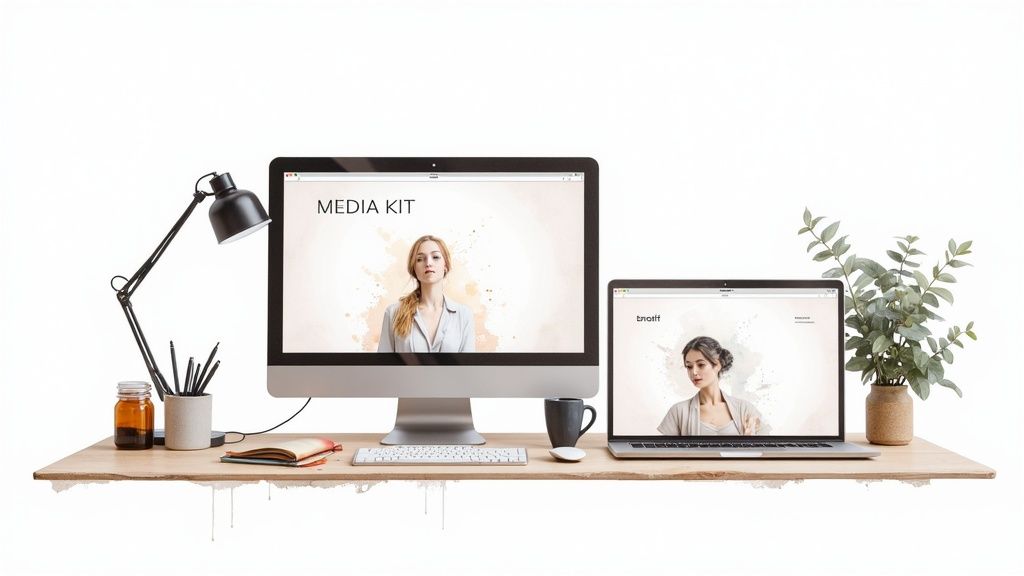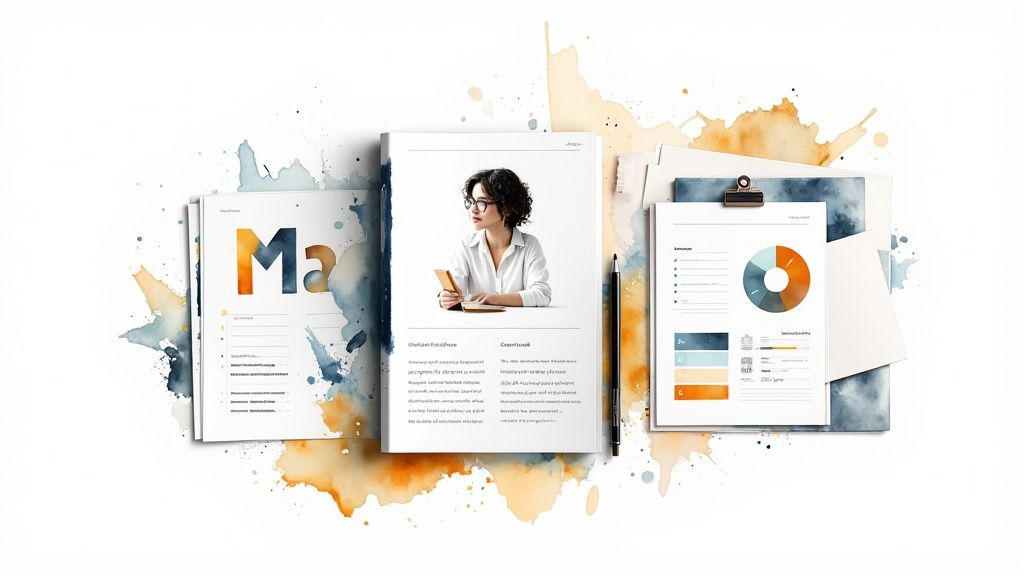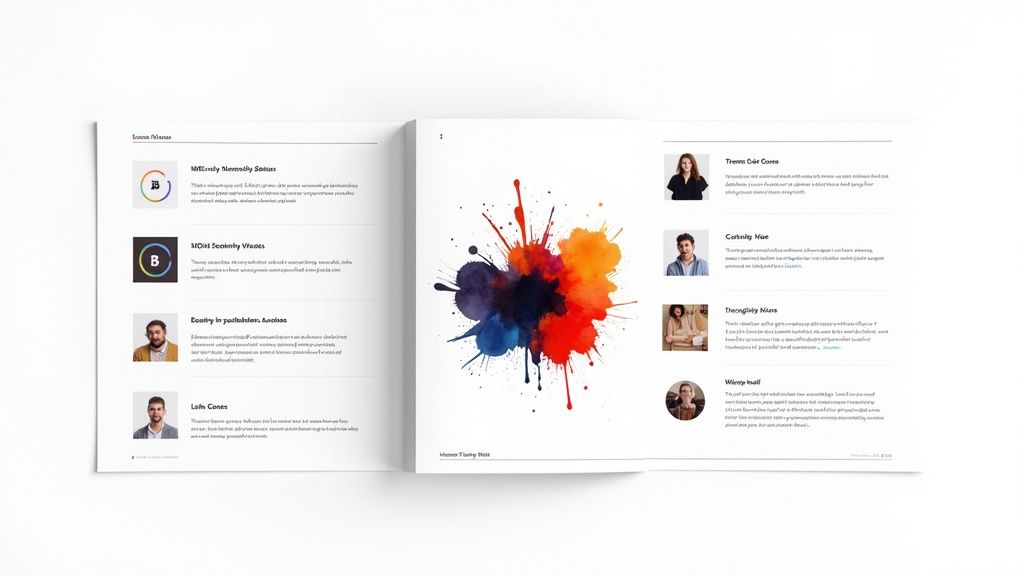Why Your Brand Needs a Compelling Media Kit
A compelling media kit is more than just a press package. It's a dynamic tool for forging partnerships and fueling brand growth. It tells your brand's story, packaged and presented to inspire collaborations. Consider it a carefully crafted elevator pitch, highlighting your unique value and clearly demonstrating why potential partners should want to work with you. This focused approach speeds up partnership discussions and establishes your brand as a serious player in a competitive market.
The Power of a Professional Presentation
A professional media kit significantly influences how potential partners perceive your brand. It showcases your commitment to quality and professionalism, signaling your genuine interest in collaboration. Much like a well-dressed professional makes a strong first impression, a polished media kit conveys credibility and expertise. This refined presentation can be what sets your brand apart from the competition. A readily available media kit also saves time and resources for everyone involved. By centralizing all essential information, it eliminates unnecessary back-and-forth communication.
Media Kits Drive Monetization and Collaboration
Creating a media kit is essential for businesses, especially online. For example, approximately two million content creators successfully monetize their work on platforms like YouTube, Instagram, and Twitch using professional media kits. These kits allow brands to understand a creator’s reach and audience engagement, informing collaboration decisions. Learn more about the importance of media kits. This highlights how media kits connect brands with creators, fostering mutually beneficial partnerships. To effectively share your media kit, explore strategies for gathering customer testimonials to further boost trust and credibility.
Real-World Examples of Media Kit Success
Numerous creators have dramatically improved their collaboration opportunities with well-designed media kits. One food blogger, for instance, saw a significant increase in brand partnership requests after incorporating high-quality food photography and detailed audience demographics into their kit. This concrete demonstration of value made it easy for brands to visualize successful collaborations. You might be interested in: How to master press releases to enhance your media outreach. Similarly, a tech reviewer who showcased strong engagement metrics and previous successful partnerships in their media kit secured lucrative collaborations with major tech companies. These success stories demonstrate the power of a compelling media kit. By presenting a clear, concise overview of your brand’s value, you can attract the right partnerships and unlock new avenues for growth.

Building Blocks of a Partnership-Winning Media Kit
Creating a media kit is like constructing a building. A solid foundation and the right components are essential for a structure that can withstand the test of time. A successful media kit doesn't just exist; it strategically showcases your brand's value, highlighting why partnering with you is a smart move. This is the key difference between a media kit that's ignored and one that generates immediate partner interest.
Crafting a Compelling Brand Narrative
The foundation of any effective media kit is a compelling brand story. This goes beyond a simple "about us" section. It addresses the fundamental question: "Why should anyone care?" Think of it as your brand's elevator pitch, emphasizing not only what you do, but why you do it and how potential partners benefit. This involves clearly defining your mission, values, and unique selling propositions. For example, a sustainable clothing brand might highlight their eco-friendly practices and ethical sourcing to attract partners who share those values.
Showcasing Your Audience: Quality Over Quantity
Beyond a strong narrative, presenting the right audience demographics is crucial. It's not about boasting large follower numbers; it's about demonstrating your audience's value to potential partners. Provide detailed insights into your audience's demographics, interests, and engagement patterns. This targeted approach allows potential partners to assess how your audience aligns with their target market, emphasizing the potential for a mutually beneficial relationship. This nuanced approach is far more effective than simply listing vanity metrics.
The Metrics That Matter: Painting a Picture of Success
This leads to the next essential element: impactful metrics. Raw numbers are important, but they rarely tell the full story. To truly connect with potential partners, contextualize your metrics and present them compellingly. This could involve showcasing your engagement rates, conversion metrics, or the success of past partnerships. For example, instead of stating "50,000 followers," you could say, "Our engaged community of 50,000 followers consistently generates a 10% click-through rate on sponsored content." Media kits are invaluable tools for businesses, especially during product launches or when seeking media coverage. They typically include detailed company information, mission statements, and press releases. Learn more about media kits here. This data-driven approach clearly illustrates your value.
Collaboration Options: Making the Value Exchange Clear
Finally, a winning media kit clearly outlines potential collaboration opportunities. This means presenting various partnership tiers, outlining the scope of each, and specifying the value exchange for all involved. By presenting your options clearly and transparently, you simplify the decision-making process for potential partners. This proactive approach showcases your professionalism and eagerness to build mutually beneficial partnerships, increasing the likelihood of turning potential leads into successful collaborations.
To summarize the essential components of a compelling media kit, the following table provides a helpful overview:
Essential Media Kit Components
A breakdown of critical elements every media kit should include, with explanations of their importance and impact.
| Component | Purpose | Best Practice Tips |
|---|---|---|
| Brand Narrative | Establishes the "why" behind your brand and resonates with potential partners' values. | Clearly articulate your mission, values, and unique selling propositions. Use storytelling to create an emotional connection. |
| Audience Demographics | Demonstrates the value of your audience to potential partners by showcasing their relevance to the partners' target market. | Go beyond vanity metrics. Provide detailed insights into your audience's interests, engagement patterns, and demographics. |
| Impactful Metrics | Provides quantifiable evidence of your success and demonstrates the potential ROI for partners. | Contextualize your metrics to tell a compelling story. Highlight engagement rates, conversion metrics, and past partnership successes. |
| Collaboration Options | Simplifies the decision-making process for potential partners and encourages conversions. | Outline clear partnership tiers with defined scopes and value exchanges for all parties involved. Be transparent and proactive. |
This table highlights the key elements necessary for creating a media kit that effectively communicates your brand's value and attracts potential partners.

Design Strategies That Capture Partner Attention
Your media kit's visual presentation is key. It can either elevate your brand or obscure your message. This section explores how successful creators leverage design to boost their credibility and grab a partner's attention. This means understanding how design choices affect perception and, ultimately, responses.
Visual Identity: Balancing Professionalism and Personality
A professional look is essential for any media kit. But that doesn't mean sacrificing your unique brand personality. The key is finding a balance between industry best practices and your distinct brand identity. For example, a vibrant color palette might reflect a youthful, energetic brand while maintaining a clean, organized layout. Always consider your target audience and the message you want to convey.
The Psychology of Effective Design
Design isn't just about aesthetics; it's about psychology. Color, typography, and spacing all play a role in how viewers perceive your brand. For example, studies show that blue evokes feelings of trust and stability, while red can signal excitement and urgency. Similarly, choosing a clear, readable font conveys professionalism, while a more whimsical font might suit a creative brand. White space is also crucial. It prevents a cluttered look and improves readability. Think of your media kit as a visual conversation. You're guiding the reader's eye and aiming for a positive, engaging experience. For more on visual communication, check out this guide on How to Master Video Ads.
Design Tools and Resources
Creating a visually compelling media kit doesn't require expert design skills. Many user-friendly tools offer pre-designed templates and drag-and-drop functionality. Canva, for instance, provides a variety of templates made specifically for media kits, simplifying the design process for everyone. These tools empower creators to develop professional-looking media kits, regardless of their design background.
Responsive Design: Adapting to Different Screens
In our mobile-centric world, responsive design is essential. Your media kit should display perfectly on any device, from desktops to smartphones. This involves using flexible layouts and scalable images to ensure consistent viewing across all screens. A responsive design shows your attention to detail and commitment to a positive user experience.

Before-and-After Examples: The Impact of Design Choices
Comparing before-and-after examples can be a powerful way to show the impact of design decisions. A cluttered, text-heavy media kit can become a sleek, visually engaging document with a few strategic changes. This visual demonstration highlights the importance of thoughtful design in capturing partner interest. By focusing on visual appeal and user experience, you can drastically improve your media kit's effectiveness. This attention to detail could be the deciding factor in securing those valuable partnerships.
Turning Your Metrics Into Compelling Partnership Stories
Raw numbers rarely impress potential partners. Instead, focus on crafting data-driven narratives that genuinely pique interest and build trust. This section explores how to transform your metrics into these compelling stories, clearly demonstrating the value you offer to brands. It involves carefully selecting, contextualizing, and visualizing your data to resonate with decision-makers.
Understanding Your Audience: What Matters to Brands?
Different brands prioritize different metrics. A fashion brand might value engagement rate and audience demographics, while a SaaS company might focus on website traffic and conversion rates. Knowing what matters to your target partners is key. Researching their industry and understanding their key performance indicators (KPIs) will help you tailor your media kit accordingly. This targeted approach shows you understand their business needs and how a partnership benefits them.
Highlighting Quality Over Quantity: Showcasing Audience Value
It's not just about audience size; it's about audience quality. A smaller, highly engaged audience is often more valuable than a larger, passive one. For example, strong click-through rates on sponsored content or a consistent history of driving conversions demonstrates your influence. Focus on metrics that highlight your audience's responsiveness and potential to connect with the brand's message.
Addressing Weak Spots Ethically: Transparency Builds Trust
Everyone has areas for improvement. If your analytics have potential weak spots, address them ethically and transparently. For example, if your follower growth has plateaued, explain the strategies you’re implementing to reignite growth. This honesty builds trust and shows potential partners that you’re proactive and always improving. Evaluating media kits is essential. For instance, a media kit might highlight '55,000 uniques', but understanding what this represents—monthly or annual—is crucial. Find more detailed statistics here.
Visualizing Data: Communicating Reach at a Glance
Data visualization is crucial for quickly and effectively communicating complex information. Charts, graphs, and infographics make your metrics more digestible and visually appealing. A line graph could show consistent growth in engagement, while a pie chart could illustrate your audience's demographic breakdown. These visuals make your data easier to understand and more memorable.
To help illustrate how different platforms prioritize different metrics, let's take a look at the table below:
Key Metrics Comparison By Platform
A comparison of which metrics matter most across different platforms and how to effectively present them in your media kit.
| Platform | Primary Metrics | Secondary Metrics | Presentation Tips |
|---|---|---|---|
| Engagement Rate, Reach, Impressions | Follower Count, Story Views | Showcase high engagement with visually appealing content, highlight reach and impressions to demonstrate potential ad visibility | |
| YouTube | Views, Watch Time, Subscriber Count | Likes, Comments, Shares | Emphasize watch time and subscriber growth to show audience loyalty, present average view duration and audience demographics |
| Blog | Unique Visitors, Page Views, Time on Site | Bounce Rate, Conversion Rate | Highlight website traffic and time spent on articles to demonstrate audience interest, showcase conversion rates for sponsored content or affiliate links |
| TikTok | Views, Likes, Shares, Comments | Follower Count, Engagement Rate | Focus on viral reach and engagement, use visually engaging content to showcase audience interaction, highlight trending sounds and hashtag usage |
| Podcast | Downloads, Listens, Listener Demographics | Reviews, Ratings | Present download numbers and listener demographics to show audience reach, highlight positive reviews and ratings to build credibility |
As you can see, understanding the nuances of each platform allows you to tailor your presentation and emphasize the most relevant data points for potential brand partnerships.
Storytelling With Data: Turning Numbers Into Narratives
Finally, weave your metrics into compelling narratives. Don't just present numbers; tell stories showcasing your work's impact. Instead of simply stating average video views, describe how a specific video campaign resonated with your audience and drove tangible results for a previous partner. This humanizes your data and demonstrates the real-world value you offer. You might also consider repurposing your video content. Learn how here.

Customizing Your Kit for Different Partnership Types
Creating a versatile media kit is crucial for attracting diverse partnership opportunities. Think of it as a Swiss Army knife: each tool has a unique function, yet they all work together. This section explores building modular content within your kit, allowing you to tailor it to specific partners efficiently.
Emphasizing Key Aspects for Different Industries
Just as outfits change with the occasion, your media kit should adapt to each potential partner. Consider their industry and tailor your message. For a sustainable brand, highlight your eco-friendly practices. For a tech company, showcase data-driven results and integrations. These subtle shifts can significantly improve your chances of a successful partnership.
Aligning Your Kit With Partner Goals and KPIs
Understanding a potential partner's key performance indicators (KPIs) is essential. Do they prioritize brand awareness, lead generation, or sales conversions? Aligning your kit with their specific goals demonstrates your value. For example, if engagement is key, showcase case studies demonstrating your success in building active communities.
Creating Specialized Versions: Advertisers, Affiliates, and More
Distinct media kit versions for different partnership types can be highly effective. Consider separate versions for advertisers, affiliates, media appearances, and influencer collaborations. An advertiser kit might focus on audience demographics and reach. An affiliate kit, however, should emphasize conversion rates and past performance. Repurposing your video content across platforms can also open doors to diverse partnerships. Check out this helpful resource: How to repurpose video content. This shows you understand their specific needs and increases the likelihood of a fruitful collaboration.
Real-World Examples: Subtle Adjustments, Big Impact
Imagine a travel blogger partnering with a hotel chain. Their standard media kit showcases their photography and audience demographics. A customized version for this partnership could include data on their audience's interest in luxury accommodations. This small change can make a big impact.
Another example: a gaming influencer partnering with a game developer. Their base media kit showcases their content and Twitch metrics. A customized version might highlight their success in driving game downloads through past partnerships, demonstrating their value to the developer.
By understanding the nuances of each partnership and tailoring your media kit, you present a stronger case for collaboration. These small adjustments can significantly impact how potential partners perceive your value, ultimately increasing your success rate.
Getting Your Media Kit in Front of Decision Makers
A well-crafted media kit is essential for any brand seeking partnerships. However, its true value lies in reaching the right audience: the decision-makers. This section explores effective strategies to distribute your media kit, ensuring it lands in the hands of those who can turn your partnership dreams into reality. This involves a mix of proactive outreach and strategic placement to enhance discoverability.
Creating a Dedicated Landing Page: Showcase and Lead Capture
A dedicated landing page for your media kit can be a powerful tool. This page serves as a central hub, showcasing key highlights and encouraging downloads. Think compelling visuals, impactful testimonials, and a concise brand story. Don't forget a clear call to action, prompting visitors to download the full kit. A lead capture form is also crucial, allowing you to gather contact information and nurture potential partnerships.
Strategic Email Outreach: Making Your Kit Stand Out
Email outreach remains a cornerstone of effective distribution. However, avoid generic emails with simple attachments. Instead, personalize each message, highlighting aspects relevant to the recipient. Mentioning a recent campaign aligned with their brand values or showcasing overlapping audience demographics can significantly increase engagement. This personalized approach demonstrates genuine interest and helps your email cut through the noise.
Making Your Kit Discoverable: Reactive Distribution Strategies
While proactive outreach is important, ensuring your media kit is easily discoverable is equally vital. This caters to brands actively seeking collaborations. Include a prominent link to your media kit on your website, perhaps in the footer or navigation menu. A dedicated "Press" or "Media Kit" section can further enhance visibility. Explore relevant online platforms and directories to expand your reach. Consider including the link in your social media bios or platforms connecting brands with influencers.
Timing and Follow-Up: Maintaining Momentum Without Being Pushy
Strategic timing can amplify your media kit's impact. Consider sending it during industry events or product launches. Follow-up is also essential, demonstrating continued interest without being overwhelming. A well-timed follow-up can rekindle interest, but excessive contact can be counterproductive. A brief message a week after your initial email, inquiring about their thoughts, can be an effective approach.
Real-World Outreach Templates: Proven Strategies for Success
Leveraging proven outreach templates can significantly boost your success rate. These templates offer a framework for crafting compelling emails, but remember to personalize them for each recipient and opportunity. Adapting proven strategies to your specific situation maximizes your chances of securing valuable collaborations.
Ready to enhance your video content creation? Aeon, a video creation platform, empowers publishers to create engaging videos effortlessly.